
Scroll down for the latest!
Snowfall this week:

Soil temps are pretty chilly right now.
https://mesonet.agron.iastate.edu/timemachine/#57.202104180000

Its chilly but this was 1 year ago:

Certainly plant hybrids that are more cold tolerant first. Be aware though that “imbibitional chilling” is a physical phenomenon that can override genetics. Imbibitional water uptake occurs within the first 48 hours after a seed is planted. Once planted, corn seeds need a two-day (48-hour) window when the soil temperature at planting depth does not drop much below 50°F. When soil temperatures drop much lower than 50°F within that two-day time frame, chilling injury may affect seed germination and subsequent seedling growth (Figure 1). During the osmotic phase of water uptake, which starts about 48 hours after the initial imbibitional phase of water uptake ends, the risk of chilling injury approaches zero. Thereafter, temperatures below 50°F can slow germination and delay seedling emergence. This can result in a longer exposure to soil-borne pathogens, particularly in soggy wet soils. If you expect the latter, use fungicide seed treatment for at least your earliest planted corn fields.
When corn seeds imbibe (take up) water, cell membranes stretch and cells expand. When a damaged cell membrane rehydrates, it may not return to its normal shape and size. This can create a "leaky" cell. Water is at its densest at about 39°F so when cold water is imbibed, it may result in additional membrane damage. These ruptured membranes may occur in the cell walls and in the mitochondria. In the plant this action may disrupt the embryo/endosperm enzymatic conversion to energy, but mostly results in leakage of cell solutes and sugars. This, in turn, is likely to reduce growth rate and interfere with growth of the emerging seedling.
See article at this link for the discussion.
https://cropwatch.unl.edu/2018/cold-soil-temperature-and-corn-planting-windows
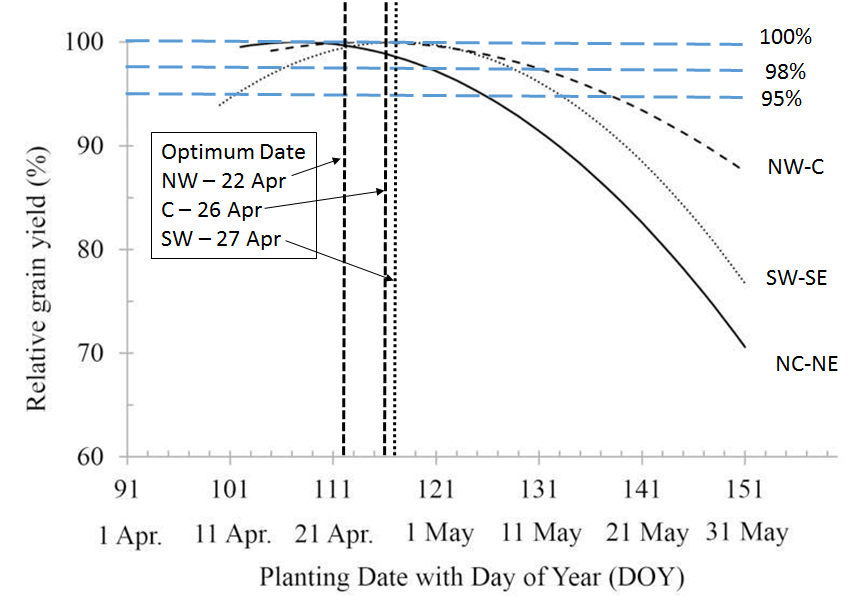
Concerning cool soils and corn planting dates, for best results, begin planting a more cold-tolerant corn hybrid when soil temperatures are in the high 40s and the short-term forecast calls for warm days that will continue pushing soil temperatures higher. If soil temperatures are in the high 40s and the weather forecast calls for cold wet conditions within the next 48 hours, soil temperatures will likely drop and planting should be delayed until temperatures warm.
Sometimes, a given year’s optimum planting date may actually be in May! Planting early is not always the best!
For more information on Soybean Planting Considerations, please see this 2017 CropWatch article.
Soybean germination consists first of a very fast uptake of water (imbibitional phase) followed by a much slower uptake of water (osmotic phase). Chilling during the first phase can cause severe problems because the imbibed water is needed to rehydrate the cotyledons and embryo to the point that cell membranes become functional. Cold temperatures interfere with proper hydration of those membranes.
During the second phase of germination, the fully functional membranes (after imbibitional hydration) create an osmotic situation in which water diffuses into the living cells. Osmotic water uptake is slow with cold temperatures. Chilling during this phase causes little direct injury to the germinating seedling. Cold temperatures will, however, slow emergence.
In conclusion, check the weather forecast, soil temperature, and hybrid/variety cold tolerance before planting. The first 24- and 48-hour periods are critical for soybean and corn, respectively, if soil temperatures dip much below 50°F. Monitor your fields based on planting date throughout the year to determine any affects on plant stand and yield.
great post on the chilling affect on seed and weather in general MM.....2 out of the last 3 years I have suffered big losses because of this problem and was forced to replant many acres. Of Course certain soil types can either compound the problem or bail you out depending.....some soils just plain warm up faster and retain water less....luck of the draw upon where you farm. We now have inches of snow and 3 nites of below 32 predicted
YW mcfarm,
Obviously, you won't be planting for at least a week but next week, conditions should improve.
Hopefully, it won't start getting too wet. We need to replenish deeper soil moisture but it would be nice for the rains to wait until after planting...........yea, wishful thinking (-:
https://www.cpc.ncep.noaa.gov/products/predictions/610day/ | |||||||||
| 6 to 10 day outlooks | |||||||||
| Click below for information about how to read 6-10 day outlook maps Temperature Precipitation | |||||||||
| Click below for archives of past outlooks (data & graphics), historical analogs to todays forecast, and other formats of the 6-10 day outlooks ArchivesAnalogsLines-Only FormatGIS Data | |||||||||
Temperature Probability | |||||||||
Precipitation Probability | |||||||||
| |||||||||
https://www.cpc.ncep.noaa.gov/products/Soilmst_Monitoring/US/Soilmst/Soilmst.shtml#
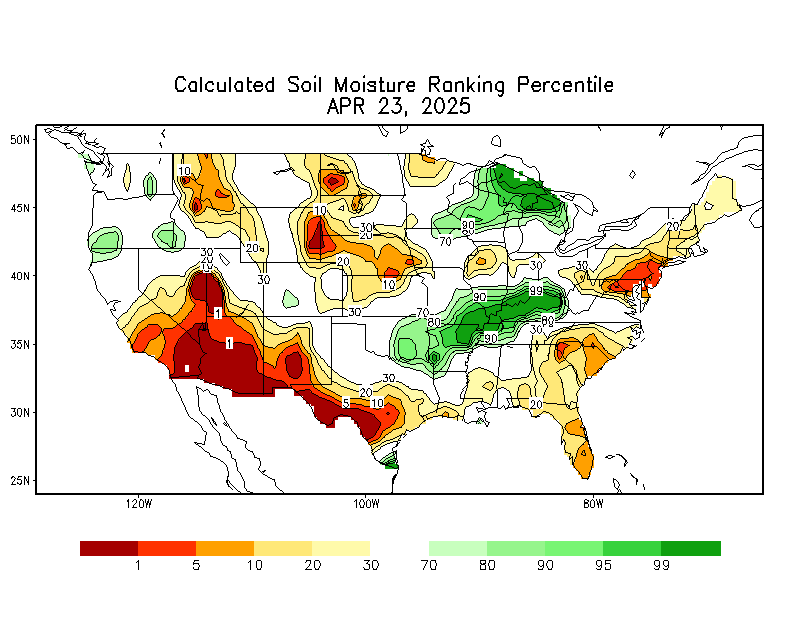
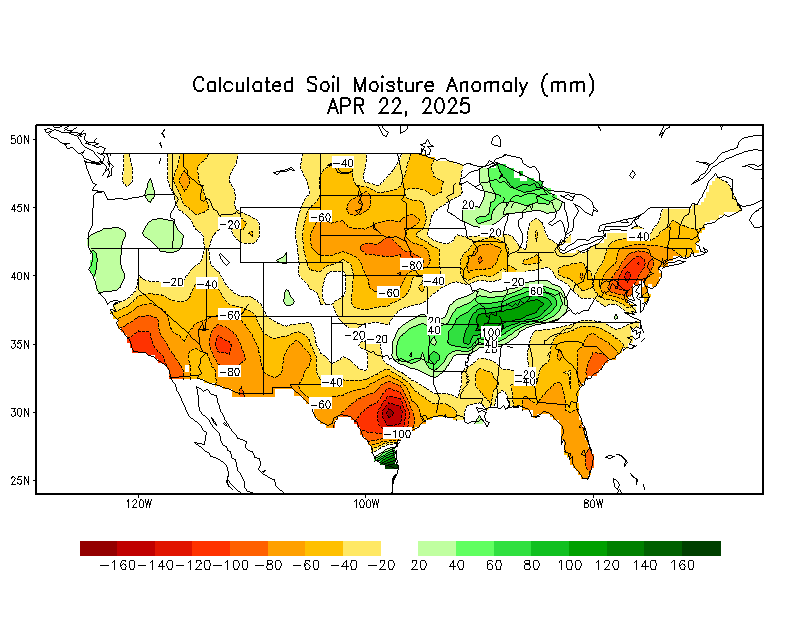
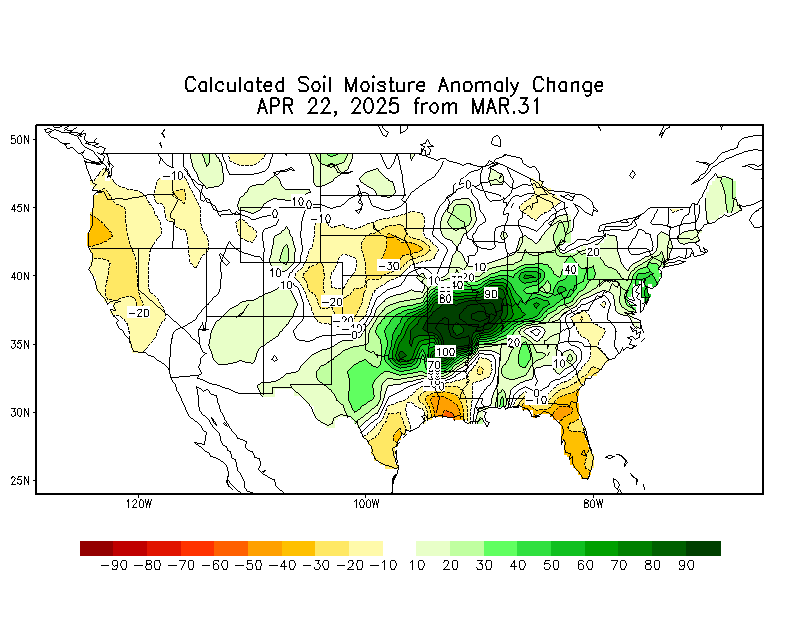
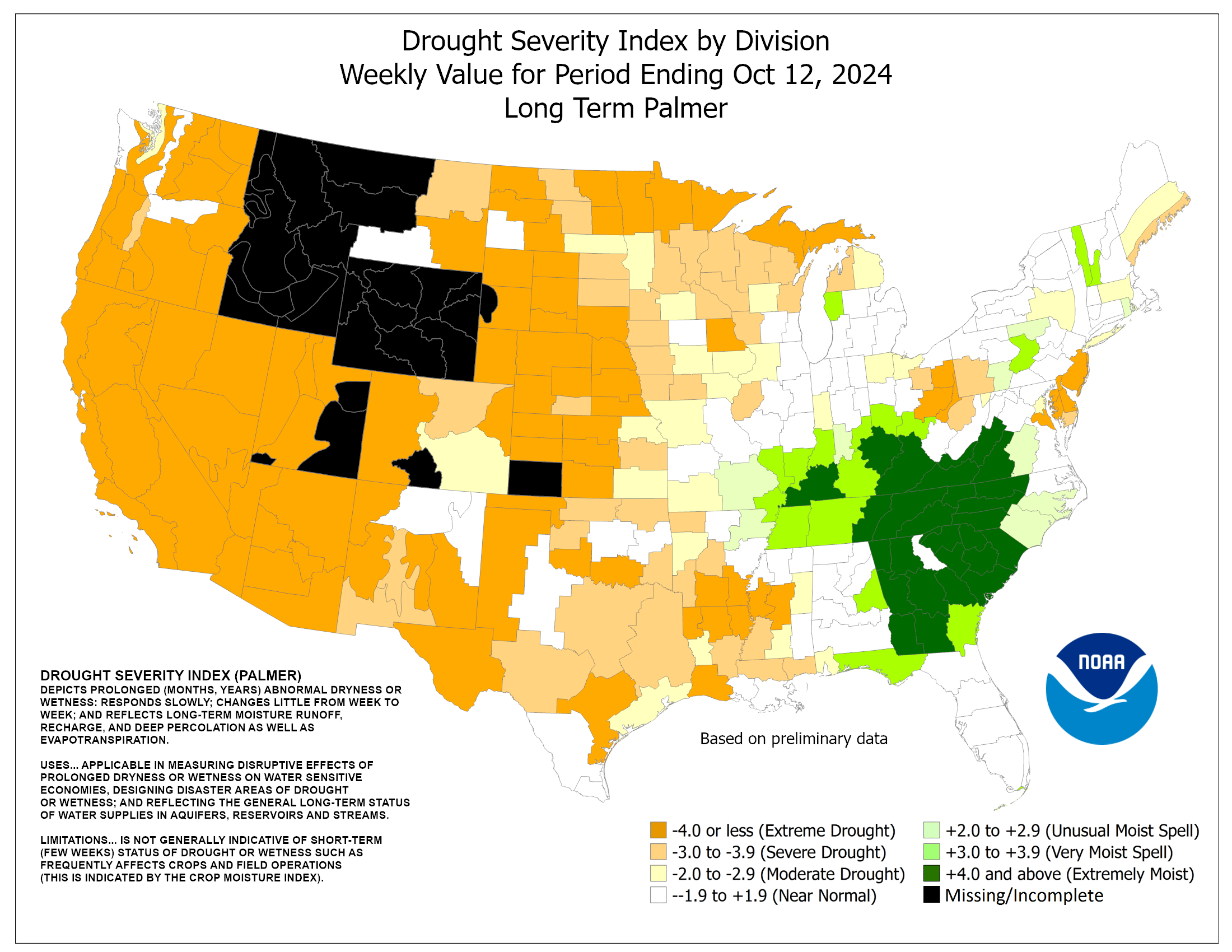
Crop moisture is very low in ND, even in the top 2 inches, there isn't enough to germinate the Spring wheat crop(but its very early and there is tons of time for rains to pick up). This map shows moisture % at 2 inches. But this is deceptive because of recent precip. A deeper profile looks much different below.
https://www.drought.gov/topics/soil-moisture
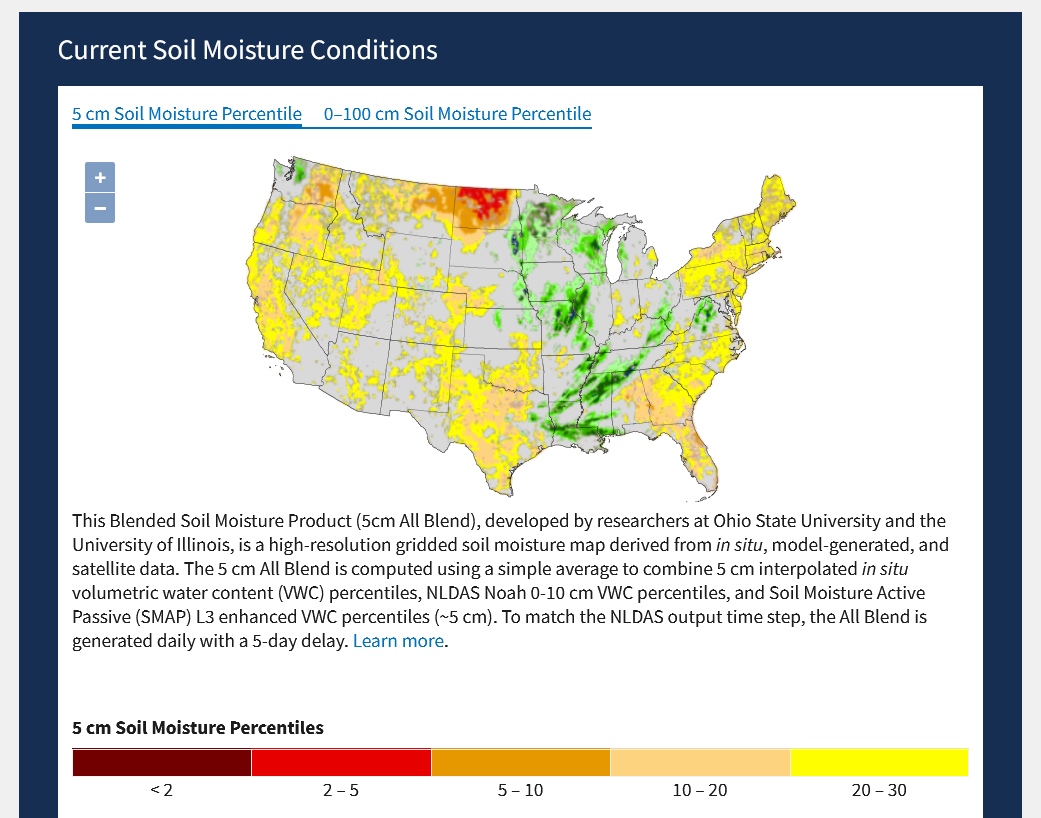
The 2nd map is very revealing. This is the soil moisture in the top 16 inches(40 cm). Wow! Look at the massive area of dark red, which means being in the top 2% of the driest in the data base across the entire Eastern Cornbelt. Also seriously dry subsoils in some places in the Central Cornbelt. ND is the worst. Might be close to the driest since the Dust Bowl for them for this time of year. Early April is when soils are often close to being the wettest of the year for most places.
If you cant's catch up with rains to recharge soil moisture in April and May, after that evaporation usually exceeds rainfall in June and gets worse in July/August.
What's interesting, is that the drought monitor is not picking up on this as well but its clear that any sort of rainfall deficits will quickly become serious because subsoil moisture is extremely low and the water table in all these locations is way down below where it usually is at this time of year.

Drought monitor does not look as dry as it really is when considering the soil profile as we did above. The first map below is last week, the 2nd map is this week. There is a huge disparity for sure with some of the maps on the previous page.
https://droughtmonitor.unl.edu/Maps/CompareTwoWeeks.aspx

On the freeze in the S.Plains tonight. Some of the jointed HRW will be vulnerable to temps below 28 degrees for several hours. This would be in parts of KS and the OK/Tx panhandle region.
Also in MO, the SRW may have some damage the next 2 nights.
KANSAS CROP PROGRESS AND CONDITION
Field Crops Report:Winter wheat condition rated 5% very poor, 11% poor, 29% fair, 48% good, and 7% excellent. Winter wheat jointed was 50%, near 48% last year and 52% for the five-year average.
https://cropwatch.unl.edu/2017/assessing-freeze-injury-wheat
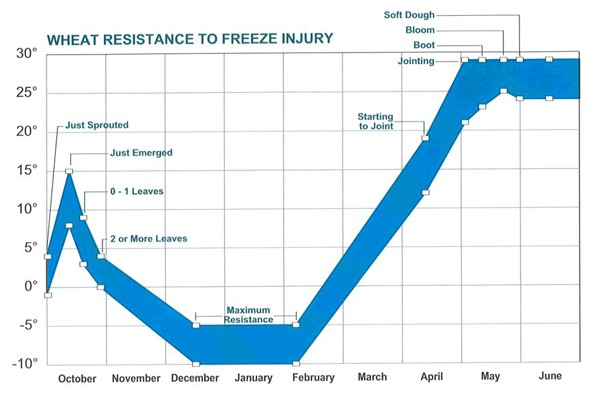
The small area with a hard freeze warning is especially likely to have some damage.
You can go to this link, (hazards) and click on the area that you want more info on.
.png)
You can track the cold temperatures here:
I think this map will be continually updated with the latest surface observations every few minutes. Already below freezing in Northwest KS with some robust winds, along with cloudy skies and a few snow flurries.
At the link below, go to observations in the top, left corner, then "surface observations"
https://www.spc.noaa.gov/exper/mesoanalysis/new/viewsector.php?sector=20#

These are the latest hazards as of 11am........note the massive area affected by cold.
Go to this link and hit hazards for the latest map. Go hit the area you are most interested in with your cursor to get more details
Weather hazards for Wed Night/Thursday morning.
Go to this link and hit hazards for the latest map. Hit the area that you are most interested about with your cursor to get more details
.png)
As you can tell, from scrolling up or hitting this link, the extended forecast has warmed up..........and added rains....but not excessive rains.
In most years, this would be bearish weather for grains, pretty good for planting and bearish for natural gas, not much heating or cooling demand.
Too much rain in the forecast now!!!!
This will cause enough planting delays that we will see the crops in the Eastern belt and possibly the Central belt having to wait for awhile into May before planting, especially corn which ideally is planted in early May in most places. Late May is not too late but this rarely results in big yields.
https://www.wpc.ncep.noaa.gov/qpf/p168i.gif?1619111080
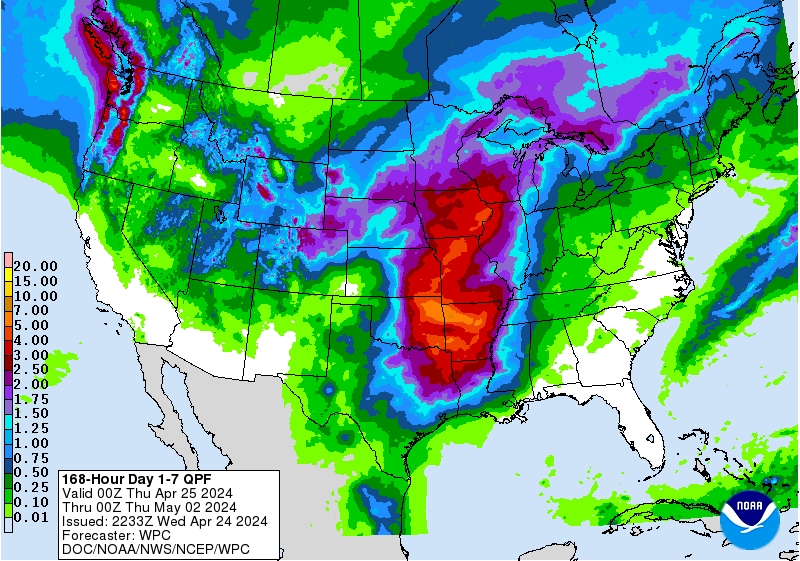
Todays huge move higher in the grains has more to do with old crops stocks not being high enough to satiate the demand before the new crop is harvested later this year.....so there must be price rationing (higher) to reduce demand down to the level of stocks that are available.
Any delays, replants, swamped acreage, cold, etc are going to be reasons for corn to rally. I think you would agree that there needs to be a perfect crop in both corn and beans. Any deviation and off we go.
Can't forget about the safrinha crop in Brazil either. From what I have read, there are some concerns growing about the dryness there.
Wonderful article and points.........thanks for sharing Jim!
Jim
These maps show how EXTREMELY dry its been in Brazil and Argentina recently.
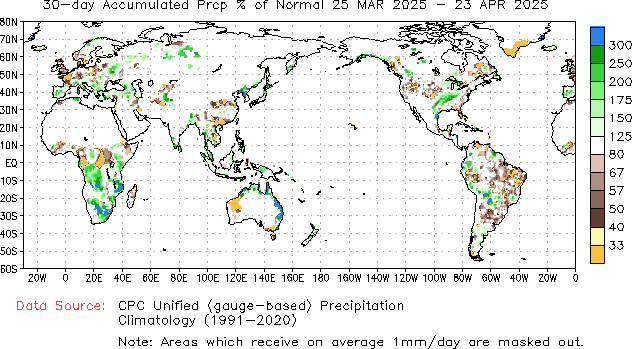
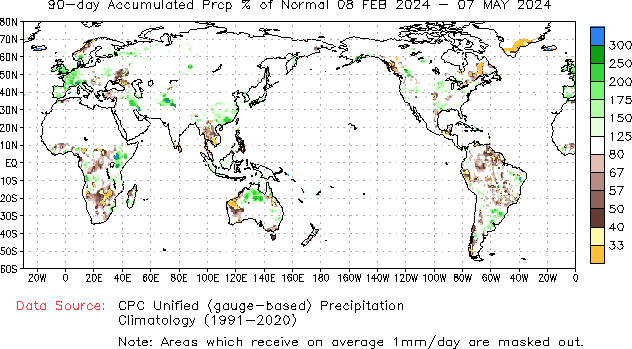
US weather getting too wet in parts of the belt. Not much rain though in places that need it the most and alot of rain now, delaying planting is a bad time to make up soil moisture deficits.
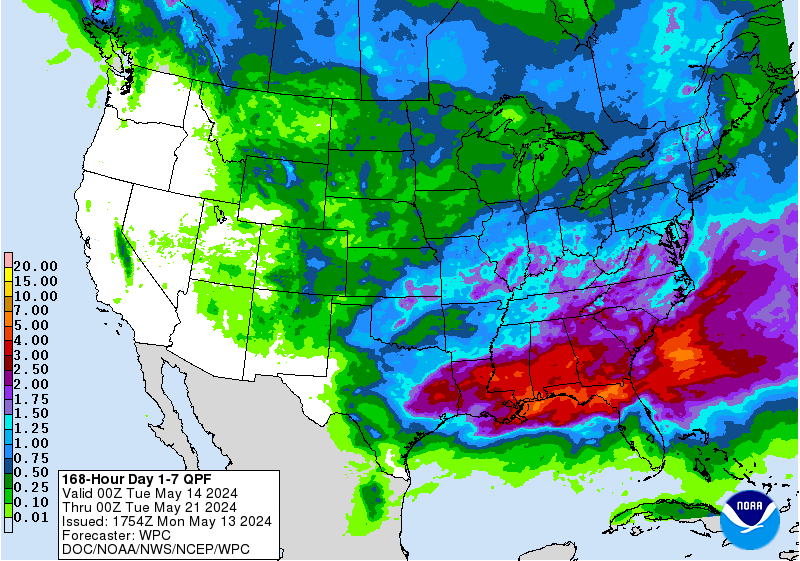
Soil temps are going up and are now warm enough to safely plant the crop in IA and will be shortly if not already in many other places. 
Low Temps:
https://www.marketforum.com/forum/topic/68198/#68202
High Temps:
https://www.marketforum.com/forum/topic/68198/#68203